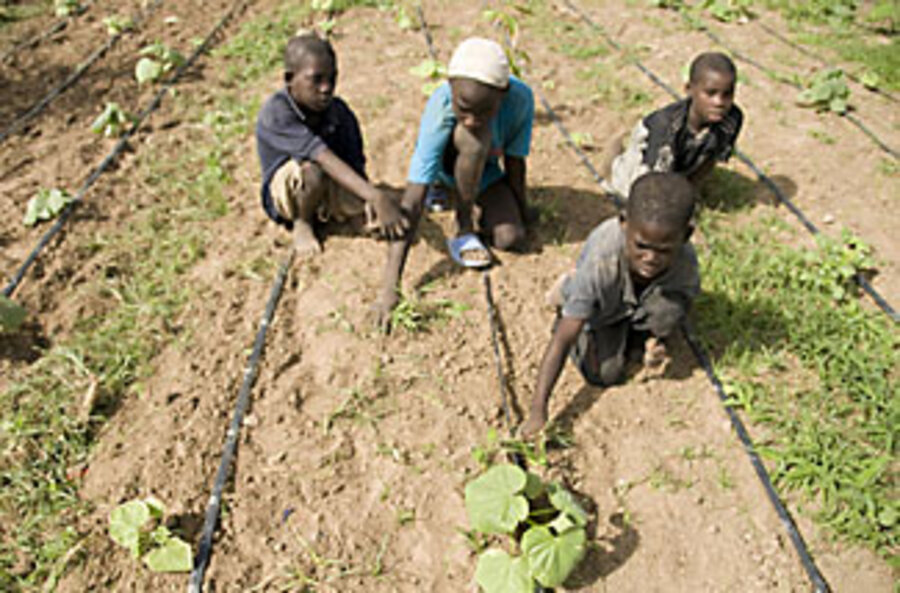New irrigation project a boon for Senegalese farmers
| Dap Dior, Senegal
D'dieme Faye's muscular arms pump energetically as she pounds millet for her family's lunch with an over-sized mortar and pestle.
In the past, Ms. Faye would have cooked a rich dish of rice, fish, and vegetables. But food prices are going up around the world, and West Africa has been one of the hardest-hit regions. The price of rice, alone, has doubled here in the past year.
"Life is too expensive," she says, "too expensive."
Her husband, Mamadou Diouf, says he hopes a new irrigation project in his village, Dap Dior, will be the answer to his family's food problems. Villagers plan to use the project, developed by the Israeli Embassy in partnership with local and international nongovernmental organizations (NGOs), to drastically increase their local production.
Traditionally, farmers in Mr. Diouf's village wait for the rainy season to plant seeds. In a semi-arid place like Senegal, the rainy season only lasts three months. And if, like last year, the rainy season falls short, entire crops can fail.
It's one of the big reasons behind the current food crisis, says Jacques Faye, director of the Rural Agricultural Prospective project. "Senegal produces less than 50 percent of what the people eat. We are very dependent on the exterior."
Like many development experts, Mr. Faye says the solution, beyond reacting to the current crisis, is to produce more food at home. "If we can make all the necessary efforts ... and investments, we could increase agricultural output very rapidly. There is a potential for production that is not being exploited."
The villagers in Dap Dior are using drip irrigation, a system of pipes that drip water directly to the roots. But in this adapted version, created especially for developing countries, each plot of 500 square meters has a blue barrel on a meter-high pedestal. Gravity provides just enough pressure to pump the water through the pipes, which have a plastic insert to guide the water uniformly across the field.
The equipment was developed by an Israeli scientist, Dov Pasternak, who specializes in agriculture in desert areas. "More than 60 percent of Israel is desert," he says. The solution there was to modernize irrigation technology – Israel has some of the most advanced irrigation technology in the world, says Pasternak, and drip irrigation is by far the most efficient.
With drip irrigation, Senegal's farmers can grow crops year round. So while Diouf's neighbors are watching the skies and only now laying seeds for their peanut crop, Diouf and the other members of the irrigation project are ready to harvest, and planning a second crop, tomatoes, for the rainy season.
"Drip irrigation means bigger yields by as much as five times," says Alioune Diouf, technical adviser to the irrigation project. And because they'll sell their peanuts now, he says they will get a better price than when the market is flooded with peanuts after the rainy season.
Ibrahima Diop, a farmer in a nearby village that installed this drip irrigation project in 2006, says he pays half as much for water as he did when he used watering cans, and he grows more: for instance, 800 kilograms of onions instead of the 550 or so he'd gotten using watering cans.
This is not the first irrigation project here. Concrete basins dot the field between the lush green peanut plants. An NGO paid to build them, along with the gas generator that pumped water out to them. The farmers would scoop the water into cans and water plants.
Now the basins are empty and cracked. It's just one of many NGO-funded irrigation projects that have been abandoned.
Those involved in the drip irrigation project say this one is different. Eric Toumieux, Senegal's country director for Worldvision, a US-based charity, says the projects often fail after a couple of years when the NGOs that started them stop managing them directly. When something breaks down, for instance, there isn't money to repair it, or the community can't agree on how to share the cost.
Mr. Toumieux, whose organization funded one of the drip irrigation projects in a different village, says this project is organized differently. Individual farmers are each responsible for their own plot. They pay their own expenses, including water and maintenance costs, but they also get all the profit. But the plots are all grouped together, and so the farmers can share technical assistance, crop marketing, and a water source.
Perhaps the most promising sign, says Eyal Yaron, the commercial adviser for the Israeli Embassy who is overseeing the installation of these projects around Senegal, is its growth. Several of the farmers have taken profits from their NGO-funded, drip-irrigated plots to buy the same equipment for their own fields.
Mamadou Diouf says he hopes to expand drip irrigation in his village. "If this project works," he says, "we'll have money to buy rice and vegetables. That's why it's so important."





